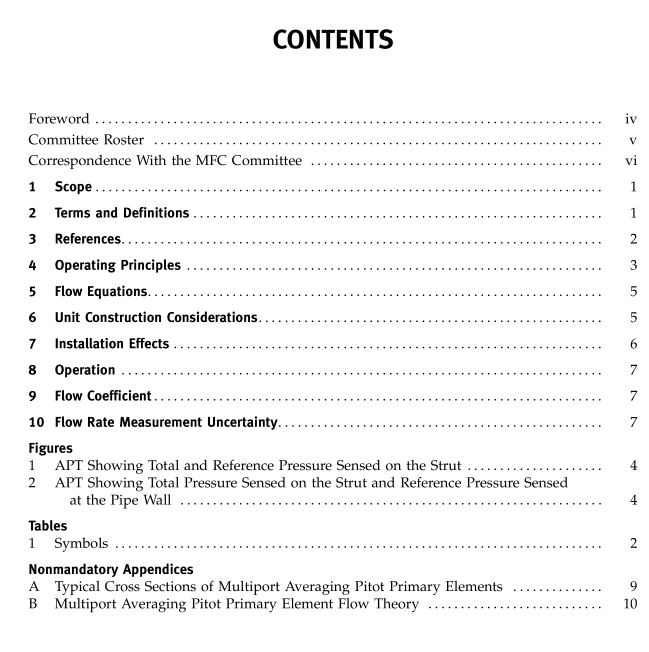ASME MFC-12M:2006 pdf free download Measurement of Fluid Flow in Closed Conduits Using Multiport Averaging Pitot Primary Elements
6.4 Hot Taps
When considering hot/ wet tap elements, the manu-facturer shall perform the structural calculations andprovide flow rates or signal limits for the following twoconditions:
(a) when the sensor is not in contact with the oppositeside of the pipe
(b) when the sensor is not in contact with the oppositeside of the pipe, while being inserted or retracted fromthe closed conduit
6.5 Materials
In addition to the requirement that the materials ofconstruction are compatible with the system processfluid, they must be compatible with the method of con-struction. When dissimilar metals are used, selectionshould be such that galvanic corrosion is not inducedto the extent that the performance and life of the deviceis impaired.Selection of the materials of constructionmust also consider atmospheric corrosion when hostileatmospheres are present.
6.6 Structural Consideration
The system must provide structural integrity withrespect to pressure, temperature, induced bending dueto fluid drag, expansion due to thermal effects, and anyother impressed loads. In addition, fluid mechanicalforces caused by the fluid flowing past the sensing ele-ment may cause the sensor to vibrate. This vibration canaffect the performance of the meter and could result infatigue failure of the sensor.Consult the manufacturerfor appropriate flow rate or signal limits for the specifiedsensor size, design, and pipe size.
7INSTALLATION EFFECTS
The primary element performance can be affected byinstallation and velocity profile. Deviations in the veloc-ity profile can be caused by in-line equipment, the pipingconfiguration,and disturbances upstream and down-stream of the primary element.
The manufacturer ‘s performance specificationsshould include a statement of the reference conditionsunder which the flow coefficient and uncertainties weredetermined.
APTs can be used to measure flow rate for gas orliquid in horizontal and vertical installations. In liquidflow applications the flow direction should be upwardsto help ensure a full pipe for flow measurement. Thepressure head difference, in vertical flows, should bezeroed out with the secondary during installation andstartup.
7.1 Velocity Profile
Manufacturers define the performance of their APTfor reference profile conditions with specific upstreamand downstream lengths of straight pipe.These lengthsare chosen to ensure the performance of the APT. Undernonreference conditions,upstream velocity profiles mayaffect the velocity profile at the flow measurement pointand influence the performance.The manufacturershould be consulted for the sensitivity of the APT tononreference flow conditions. In some cases, the use ofa flow conditioner may restore the velocity profile tothe reference profile.
7.2 Upstream and Downstream Pipe Length
Requirements
The minimum upstream and downstream straightlengths of pipe required to meet the performance specifi-cation of the APT should be stated by the manufacturer.The minimum lengths required downstream of differentpipe fittings may vary for each APT and piping configu-ration.
When the flow measurement application or installa-tion configuration does not match one of the manufac-turer’s listed applications and installations, theflowmeter manufacturer should be consulted.If themanufacturer cannot provide sufficient guidance, in-situcalibration may be considered.
ln-situ calibration establishes the flow coefficient ofthe APT and uncertainty under actual operating condi-tions.If in-situ calibration is performed, the calibrationshould be done in accordance with acceptable standardsas listed in section 3. If in-situ calibration is not possible,the effect of installation can be reduced by performinga flow laboratory calibration of the meter replicating theactual upstream and downstream piping installations.7.3 Alignment and Orientation
7.3.1 Alignment. The manufacturer shall specifythe limits of the allowable angular tolerances for theinstallation of the APT. Deviation of the APT primaryelement in any angular alignment from the allowablelimits can result in erroneous flow measurement.
7.3.2 Orientation.Manufacturers shall specify pre-ferred APT locations and orientations with respect tothe horizontal or vertical axis of the flow conduit.Thesepreferred orientations may depend on the fluid beingmeasured.
7.4 Conduit lnternal Surface Condition
Surface roughness of the flow conduit can affect thevelocity distribution at the metering location. The manu-facturer should advise the user on the effects of internalpipe surfaces. In some cases, buildup of mineral or otherdeposits on the internal wall of the conduit may alterthe velocity distribution or obscure the APT sensingports. The installer should determine the condition of
ASME MFC-12M:2006 pdf free download
